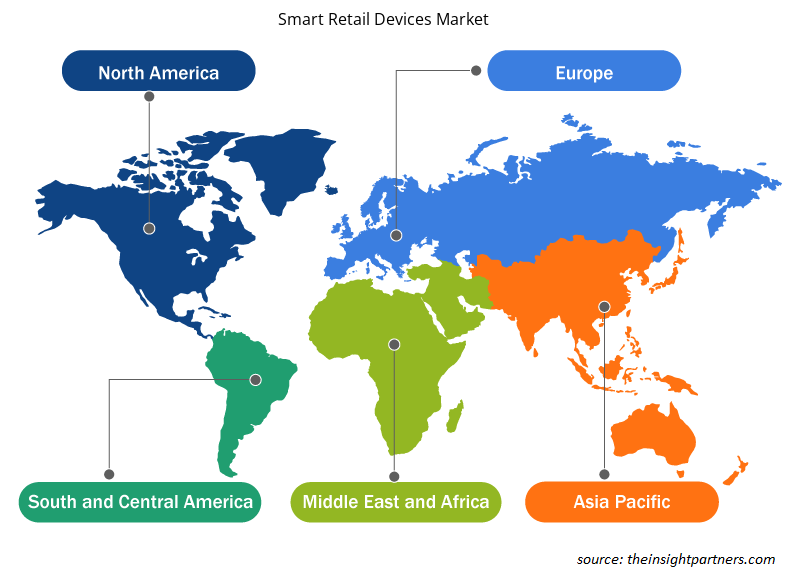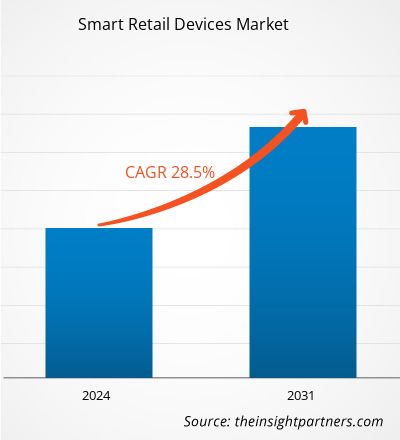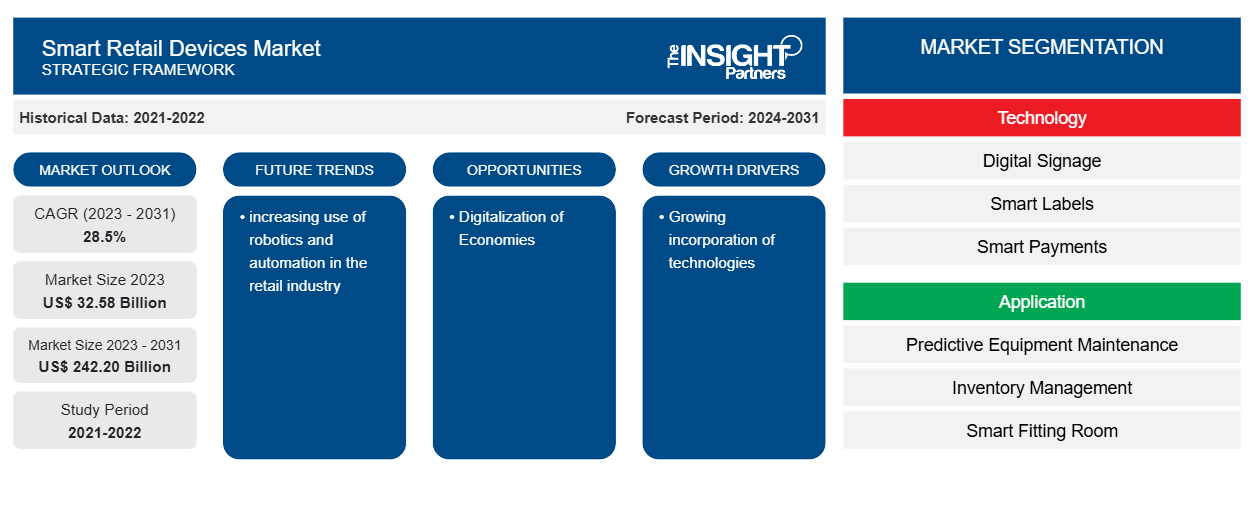Der Markt für intelligente Einzelhandelsgeräte soll von 32,58 Milliarden US-Dollar im Jahr 2023 auf 242,20 Milliarden US-Dollar im Jahr 2031 wachsen; von 2024 bis 2031 wird eine durchschnittliche jährliche Wachstumsrate von 28,5 % erwartet. Der zunehmende Einsatz von Robotik und Automatisierung im Einzelhandel dürfte ein wichtiger Markttrend für intelligente Einzelhandelsgeräte bleiben.
Marktanalyse für intelligente Einzelhandelsgeräte
Die zunehmende Nutzung von Big Data-Analysen und des Internets der Dinge (IoT) im Einzelhandel sowie die steigende Kaufkraft der Verbraucher sind die wichtigsten Antriebsfaktoren für den Markt intelligenter Einzelhandelsgeräte.
Marktübersicht für intelligente Einzelhandelsgeräte
Smart Retail ist der Einsatz von Technologie und Daten, um das Einkaufserlebnis der Kunden und die Betriebsabläufe von Unternehmen zu verbessern. Diese Technologien ermöglichen es Unternehmen, das Kundenerlebnis zu verbessern, Abläufe zu optimieren und wichtige Erkenntnisse über das Verbraucherverhalten zu gewinnen. Diese mit dem Internet verbundenen Geräte ermöglichen Benutzern den einfachen Zugriff auf maßgeschneiderte Informationen und Dienste, während ausgefeilte Funktionen wie Spracherkennung und Touchpad-Integration das Einkaufen zum Kinderspiel machen. Virtuelle Assistenten führen Verbraucher dabei, die richtigen Waren auszuwählen , interessante Angebote zu durchstöbern, Einkäufe zu tätigen und sogar Erfahrungen festzuhalten und in sozialen Medien zu teilen.
Passen Sie diesen Bericht Ihren Anforderungen an
Sie erhalten kostenlos individuelle Anpassungen an jedem Bericht, einschließlich Teilen dieses Berichts oder einer Analyse auf Länderebene, eines Excel-Datenpakets sowie tolle Angebote und Rabatte für Start-ups und Universitäten.
-
Holen Sie sich die wichtigsten Markttrends aus diesem Bericht.Dieses KOSTENLOSE Beispiel umfasst eine Datenanalyse von Markttrends bis hin zu Schätzungen und Prognosen.
Markttreiber und Chancen für intelligente Einzelhandelsgeräte
Wachsende Integration von Technologien zur Begünstigung des Marktes
Die Integration von Technologien wie Künstlicher Intelligenz (KI), Virtueller Realität (VR), Erweiterter Realität (AR) und dem Internet der Dinge (IoT) wird im Einzelhandel zunehmend genutzt, um das Einkaufserlebnis zu verbessern, die Bestandsverwaltung zu optimieren und den Ladenbetrieb zu optimieren. Das Internet der Dinge (IoT) ist eine wichtige Komponente im intelligenten Einzelhandelsumfeld, da es Geräte mit dem Internet verbindet und wichtige Daten zu Kundenverhalten, Ladenbetrieb und Bestandsverwaltung liefert. IoT-Geräte wie Sensoren und Beacons ermöglichen es Händlern, Echtzeitdaten zu Lagerbeständen, Kundenströmen und Ladenvermögen zu erfassen, sodass sie fundiertere Entscheidungen treffen und den Betrieb optimieren können.
Digitalisierung der Volkswirtschaften
Der Einsatz der Digitalisierung bietet Geschäften mehrere Vorteile, darunter die Gewinnung neuer Kunden und die Senkung der Betriebskosten. Darüber hinaus kann die Digitalisierung das Einzelhandelspersonal deutlich motivieren. Infolgedessen können Einzelhändler einen Anstieg ihrer Umsätze verzeichnen. Insbesondere der Einkauf außerhalb von Geschäften verzeichnete im Jahr 2020 ein deutliches Wachstum. Online-Einzelhandelsgeschäfte werden wahrscheinlich enorm von technologischen Verbesserungen, einer verbesserten Vernetzung, der Einführung neuartiger Sensoren und der Verfügbarkeit nahtloser Kommunikationslösungen profitieren und so im gesamten Prognosezeitraum erheblich zum Marktwachstum beitragen.
Segmentierungsanalyse des Marktberichts zu intelligenten Einzelhandelsgeräten
Schlüsselsegmente, die zur Ableitung der Marktanalyse für intelligente Einzelhandelsgeräte beigetragen haben, sind Technologie und Anwendung.
- Basierend auf der Technologie ist der Markt in Digital Signage, Smart Labels, Smart Payments, Smart Carts und andere unterteilt. Das Segment Digital Signage hatte im Jahr 2023 einen größeren Marktanteil.
- In Bezug auf die Anwendung ist der Markt in vorausschauende Gerätewartung, Bestandsverwaltung, intelligente Umkleidekabinen, Fußgängerverkehrsüberwachung und andere unterteilt. Das Segment Bestandsverwaltung hatte im Jahr 2023 einen größeren Marktanteil.
Marktanteilsanalyse für intelligente Einzelhandelsgeräte nach Geografie
Der geografische Umfang des Marktberichts für intelligente Einzelhandelsgeräte ist hauptsächlich in fünf Regionen unterteilt: Nordamerika, Asien-Pazifik, Europa, Naher Osten und Afrika sowie Südamerika/Süd- und Mittelamerika. Nordamerika dominierte den Markt für intelligente Einzelhandelsgeräte im Jahr 2023. Es wird erwartet, dass diese Region während des gesamten prognostizierten Zeitraums der größte Umsatzbringer auf dem Markt sein wird. Der zunehmende Wunsch nach High-End-Produkten und Luxusartikeln, gepaart mit der dynamischen Verschiebung der Kundenpräferenzen hin zu bequemeren und zeiteffizienteren Einkaufserlebnissen, sind die Hauptfaktoren, die diesen Trend vorantreiben. Darüber hinaus verändert die weit verbreitete Integration digitaler Technologien in verschiedenen Sektoren die US-Wirtschaft. Die Folgen der Pandemie haben die digitale Transformation von Unternehmen im Einzelhandel erheblich beschleunigt und frühere Erwartungen übertroffen.
Regionale Einblicke in den Markt für intelligente Einzelhandelsgeräte
Die regionalen Trends und Faktoren, die den Markt für intelligente Einzelhandelsgeräte im Prognosezeitraum beeinflussen, wurden von den Analysten von Insight Partners ausführlich erläutert. In diesem Abschnitt werden auch die Marktsegmente und die Geografie für intelligente Einzelhandelsgeräte in Nordamerika, Europa, im asiatisch-pazifischen Raum, im Nahen Osten und Afrika sowie in Süd- und Mittelamerika erörtert.

- Holen Sie sich die regionalen Daten für den Markt für intelligente Einzelhandelsgeräte
Umfang des Marktberichts zu intelligenten Einzelhandelsgeräten
| Berichtsattribut | Details |
|---|---|
| Marktgröße im Jahr 2023 | 32,58 Milliarden US-Dollar |
| Marktgröße bis 2031 | 242,20 Milliarden US-Dollar |
| Globale CAGR (2023 - 2031) | 28,5 % |
| Historische Daten | 2021-2022 |
| Prognosezeitraum | 2024–2031 |
| Abgedeckte Segmente |
Nach Technologie
|
| Abgedeckte Regionen und Länder |
Nordamerika
|
| Marktführer und wichtige Unternehmensprofile |
|
Marktteilnehmerdichte: Der Einfluss auf die Geschäftsdynamik
Der Markt für intelligente Einzelhandelsgeräte wächst rasant, angetrieben durch die steigende Nachfrage der Endnutzer aufgrund von Faktoren wie sich entwickelnden Verbraucherpräferenzen, technologischen Fortschritten und einem größeren Bewusstsein für die Vorteile des Produkts. Mit steigender Nachfrage erweitern Unternehmen ihr Angebot, entwickeln Innovationen, um die Bedürfnisse der Verbraucher zu erfüllen, und nutzen neue Trends, was das Marktwachstum weiter ankurbelt.
Die Marktteilnehmerdichte bezieht sich auf die Verteilung von Firmen oder Unternehmen, die in einem bestimmten Markt oder einer bestimmten Branche tätig sind. Sie gibt an, wie viele Wettbewerber (Marktteilnehmer) in einem bestimmten Marktraum im Verhältnis zu seiner Größe oder seinem gesamten Marktwert präsent sind.
Die wichtigsten auf dem Markt für intelligente Einzelhandelsgeräte tätigen Unternehmen sind:
- Intel Corporation
- Samsung-Gruppe
- NVIDIA CORPORATION
- LG Electronics
- Zebra Technologies Corporation
- Caper Inc.
Haftungsausschluss : Die oben aufgeführten Unternehmen sind nicht in einer bestimmten Reihenfolge aufgeführt.

- Überblick über die wichtigsten Akteure auf dem Markt für intelligente Einzelhandelsgeräte
Marktnachrichten und aktuelle Entwicklungen zu intelligenten Einzelhandelsgeräten
Der Markt für intelligente Einzelhandelsgeräte wird durch die Erfassung qualitativer und quantitativer Daten nach Primär- und Sekundärforschung bewertet, die wichtige Unternehmensveröffentlichungen, Verbandsdaten und Datenbanken umfasst. Im Folgenden finden Sie eine Liste der Entwicklungen auf dem Markt:
- Im Juni 2023 haben Intel und Vericast ihre Kräfte gebündelt, um ein hochmodernes programmierbares digitales In-Store-Einzelhandelsmediennetzwerk zu entwickeln, zu implementieren und zu evaluieren. Dieses innovative System nutzt die fortschrittliche Targeting-Technologie von Vericast und die leistungsstarken Edge-Softwareplattformen von Intel, um personalisierte Werbung und Produktdetails bereitzustellen, die auf das Einkaufserlebnis des Kunden abgestimmt sind. Diese Zusammenarbeit ist ein entscheidender Bestandteil unserer umfassenderen Initiative, den Einzelhandel zu revolutionieren und von der digitalen Transformation physischer Geschäfte zu profitieren, die allgemein als der nächste große Trend in der Werbebranche angesehen wird.
(Quelle: Intel, Pressemitteilung, 2023)
- Im November 2023 stellte Panasonic Connect Europe eine neue KI-gestützte Lösung vor, die den Einzelhandel verändern soll, indem sie Werbung durch generative KI-Assistenten für Kunden beim Einkaufen personalisiert. Diese innovative Lösung ermöglicht es Geschäften, die demografische Zusammensetzung der Käufer automatisch zu überwachen und diese Informationen mit Kaufpräferenzen, Wetterdaten und lokalen Ereignissen zu kombinieren, um Werbung auf Displays im Geschäft sofort zu personalisieren. Panasonic hat sich mit ADEAL Systems, einem führenden Daten- und KI-Spezialisten, zusammengetan, um seinen KI-gestützten persönlichen Einkaufsassistenten CUSAAS (Customer Segmentation As-A-Service) mit hochmodernen Kamera- und Displaylösungen für den Einzelhandel zu integrieren und so ein verbessertes Einkaufserlebnis zu schaffen.
(Quelle: Panasonic, Pressemitteilung, 2023)
Marktbericht zu intelligenten Einzelhandelsgeräten – Abdeckung und Ergebnisse
Der Bericht „Marktgröße und Prognose für intelligente Einzelhandelsgeräte (2021–2031)“ bietet eine detaillierte Analyse des Marktes, die die folgenden Bereiche abdeckt:
- Marktgröße und Prognose auf globaler, regionaler und Länderebene für alle wichtigen Marktsegmente, die im Rahmen des Projekts abgedeckt sind
- Marktdynamik wie Treiber, Beschränkungen und wichtige Chancen
- Wichtige Zukunftstrends
- Detaillierte PEST/Porters Five Forces- und SWOT-Analyse
- Globale und regionale Marktanalyse mit wichtigen Markttrends, wichtigen Akteuren, Vorschriften und aktuellen Marktentwicklungen
- Branchenlandschaft und Wettbewerbsanalyse, einschließlich Marktkonzentration, Heatmap-Analyse, prominenten Akteuren und aktuellen Entwicklungen
- Detaillierte Firmenprofile
- Historische Analyse (2 Jahre), Basisjahr, Prognose (7 Jahre) mit CAGR
- PEST- und SWOT-Analyse
- Marktgröße Wert/Volumen – Global, Regional, Land
- Branchen- und Wettbewerbslandschaft
- Excel-Datensatz
Aktuelle Berichte
Erfahrungsberichte
Grund zum Kauf
- Fundierte Entscheidungsfindung
- Marktdynamik verstehen
- Wettbewerbsanalyse
- Kundeneinblicke
- Marktprognosen
- Risikominimierung
- Strategische Planung
- Investitionsbegründung
- Identifizierung neuer Märkte
- Verbesserung von Marketingstrategien
- Steigerung der Betriebseffizienz
- Anpassung an regulatorische Trends























 Kostenlose Probe anfordern für - Markt für intelligente Einzelhandelsgeräte
Kostenlose Probe anfordern für - Markt für intelligente Einzelhandelsgeräte